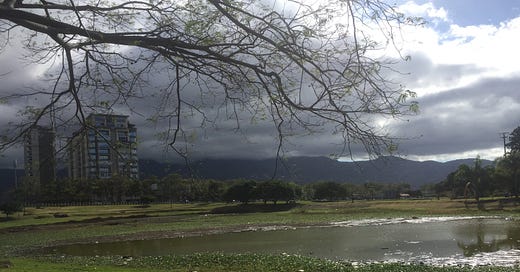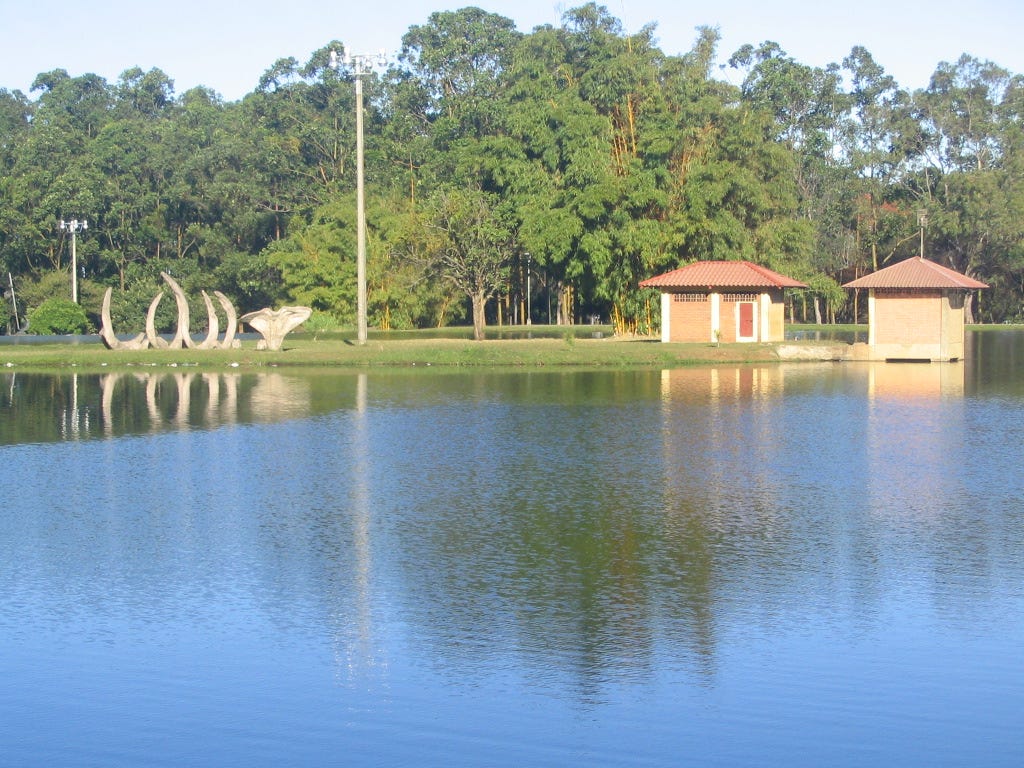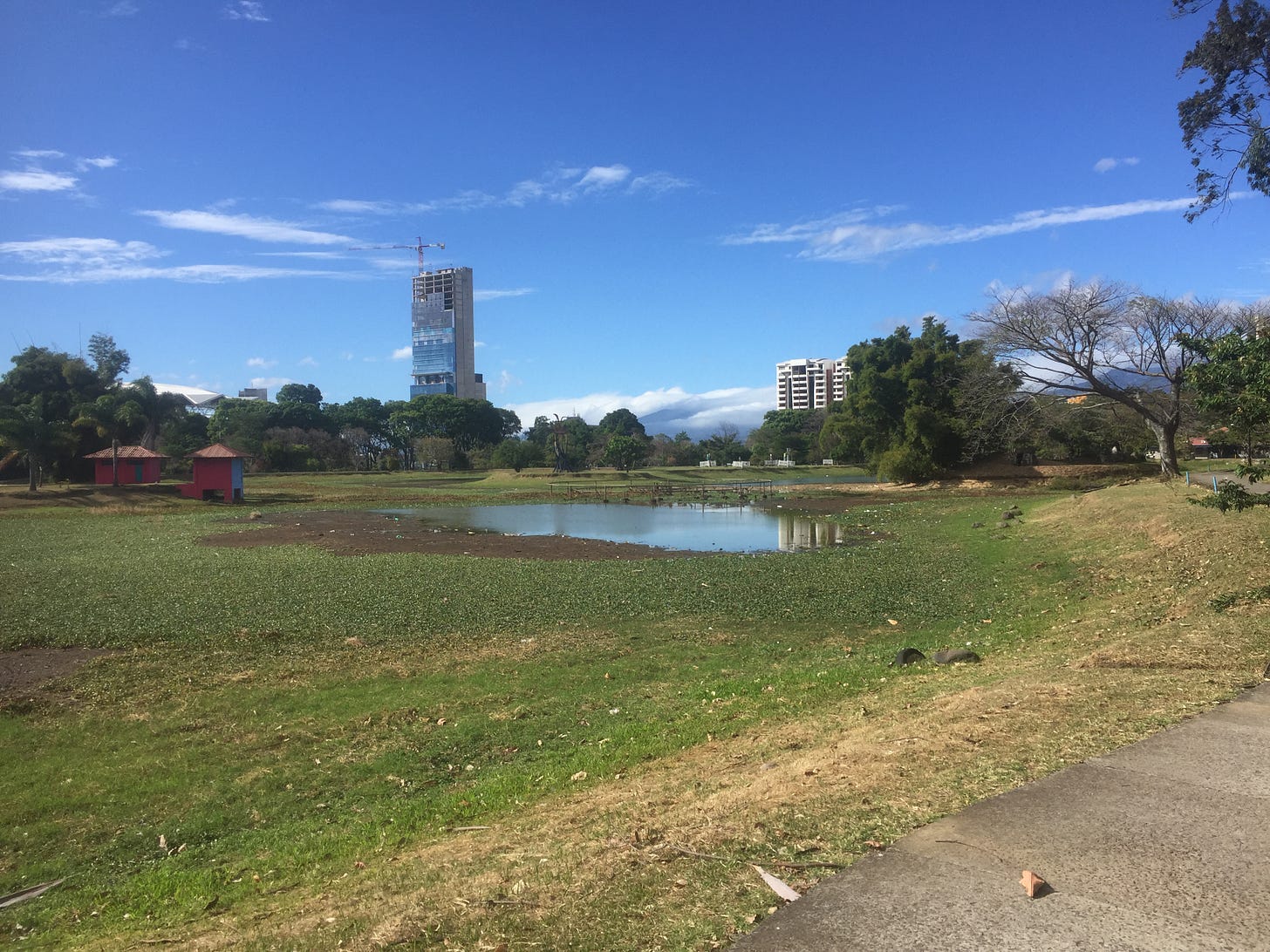#52 - Did climate change erase my favourite childhood spot?
By Sebastián Rodríguez in San José, Costa Rica
Welcome to this latest edition of From a Climate Correspondent. If you'd like to support us, check out our Patreon page, or invite us for a coffee over at KOFI page. Thanks for reading!
For me, walking through La Sabana is like travelling back in time.
La Sabana is Costa Rica’s main metropolitan park, in the centre of its capital, San José. This was one of the places I most frequented while growing up, but it feels different now. The soil is drier.
Today, I marched through the football fields, where I celebrated my 11th birthday with a friendly match. I passed by the hills where I used to hang around with my cousins on summer holidays. After walking for a few minutes, I came back to the present.
In front of me, a puddle of water lay in the centre of an empty lake. The structure is there, like an empty container, but the water is missing. After years of droughts, this has become the standard view of this lake during the dry season.
Climate connections?
It wasn’t always this way. Growing up in the 2000s, I used to visit this lake with my grandparents during summer holidays in January. We would buy loaves of bread and feed ducks of all colours and sizes. Boats even took people for rides around the lake.
The lake first dried up back in 2013. The west side of the lake started to lose water during the dry season, leaving a large part of the bottom exposed. Then, during 2015’s El Niño event, the lake went completely dry. This happened again during 2019’s El Niño. These events cause extremely dry conditions and they may be getting stronger because of climate change.
As I write this, I’m standing in front of the empty lake. By now, it’s part of the landscape during the dry season. There are no formal studies in this particular lake, but climate change may well be driving its drought, and may mean it gets worse in the future, Hugo Hidalgo, director of the Center of Geophysical Research at the University of Costa Rica, later tells me.
Hidalgo’s concerns are not due to an expected lack of rainfall: in fact, climate models show a lack of rainfall in this part of the country happening only at the very end of the century.
The problem, says Hidalgo, is the rising heat. Models have shown temperatures in the area could increase by 3C to 4C compared to pre-industrial times, he says. When the atmosphere heats up, it starts to absorb more water. “Imagine the atmosphere getting thirsty. It absorbs water from the ground and makes it drier. Vegetation ends up more arid.”
Urban adaptation
In cities like San José, these arid conditions could end up altering the urban landscape to a more yellowish vegetation. It may also contribute to drying up small lakes like La Sabana’s, as well as rivers, aquifers and other sources of water.
To face these new conditions, cities will have to adapt. La Sabana’s lake, for example, depends only on rainfall for its water; it's forbidden to use drinking water to fill it up. But some scientists have now proposed the use of nearby rivers as a water source during the dry season. The park administration has said that another possibility is connecting the lake to underground wells. But no formal plan is yet being implemented.
La Sabana is not the only park in Costa Rica with this issue. La Paz park’s lake, which lies on the eastern side of San José and is another recreational hotspot for urban citizens, also went completely dry in recent summers. Here, it was first recorded to happen in 2018.
This may seem like just an aesthetic problem, but healthy recreational parks have become more important as the climate crisis progresses. Green infrastructure such as city lakes can help cool down urban areas from increasing heat.
But, for me at least, this also has emotional implications. I did not expect to feel a sort of nostalgia coming back, nor anticipate feeling so saddened to witness the degradation of one of my childhood’s favourite places.
As I left the spot where a few months ago a big body of water had stood in the heart of Costa Rica’s largest urban park, I now saw a small group of pigeons, scrambling in between the muddy ponds in their search for water.
Sebastián writes about climate and biodiversity issues from San José, Costa Rica. Find him on twitter @sebastianrodvar.
This post was funded by a climate investigation grant awarded to From A Climate Correspondent by the European Federation for Science Journalism (EFSJ) and funded by the BNP Paribas Foundation.
If you’d like to support us to publish more journalism from the front lines of climate change, please consider supporting us with a regular donation on Patreon or inviting us for a one-time coffee over at KOFI. You can also support use by signing up and sharing this article with others!
Must reads from the region
Lithium's grays, Yasna Mussa, Revista Late
Lithium is a fundamental component of the batteries in electric vehicles. However, mining activity for this element relates to a dictatorship in Chile and environmental impacts in the Atacama desert.
Family men or forest destroyers? Meet the miners living off the Amazon's gold, Lucas Landau and Fabio Teixeira, Thomson Reuters Foundation News
Reporters Lucas Landau and Fabio Teixeira accompany a group of illegal gold miners for an extraction trip in the Amazon. The miners describe themselves as family men supporting their families.
Land of Resistants, Andrés Bermúdez and other writers, Tierra de Resistentes
A group of over 70 journalists from all over Latin America set out to track all of the attacks on environmental defenders in the region. They find special impunity for crimes against black and indigenous minorities.
What else I’ve been watching
I'm reading David Quammens' The Tangled Tree, which tells the story of how a group of scientists redefined the history of life with the discovery of Archaea, a brand new domain of living beings. He manages to tell a very human story behind the scientific breakthrough, while explaining extremely complex concepts with very simple words.
Who we are
From A Climate Correspondent is a weekly newsletter exploring the climate crisis from around the globe run by four journalists. We regularly feature guest writers.
Lou Del Bello is an energy and climate journalist based in Delhi, India.
Jocelyn Timperley is a climate journalist based in San José, Costa Rica.
Purple Romero is an climate change and human rights journalist based in Hong Kong.
Mat Hope is investigative journalist based in Nairobi, Kenya.
Been forwarded this email?
Did someone send this on to you? Why not sign up yourself!





